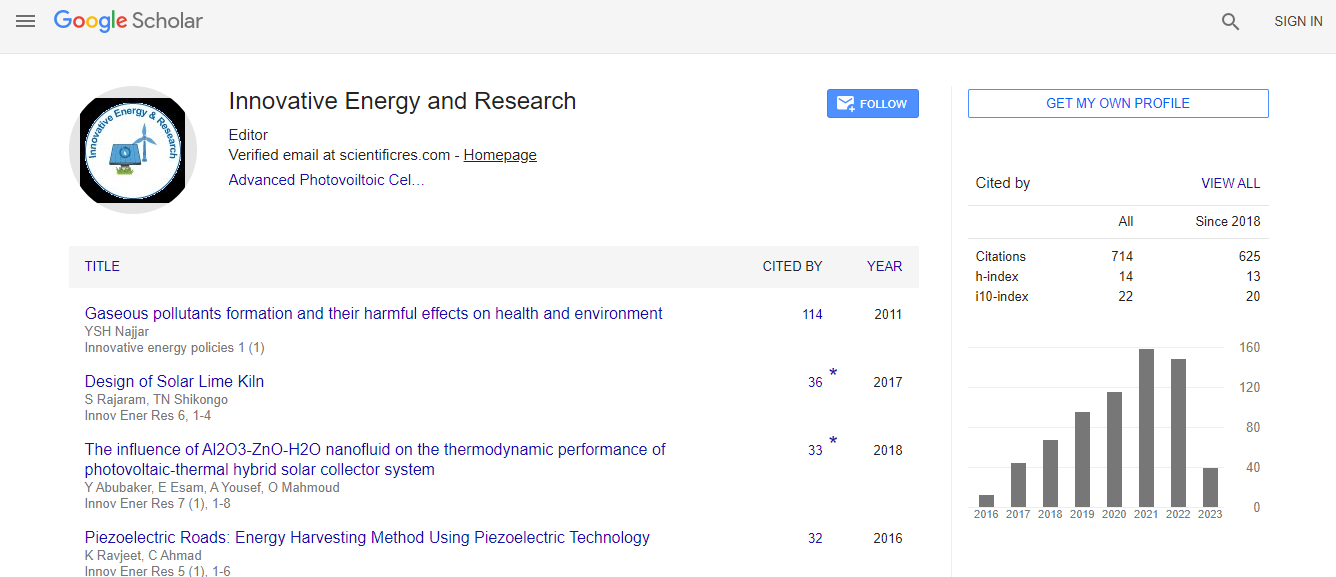Our Group organises 3000+ Global Conferenceseries Events every year across USA, Europe & Asia with support from 1000 more scientific Societies and Publishes 700+ Open Access Journals which contains over 50000 eminent personalities, reputed scientists as editorial board members.
Open Access Journals gaining more Readers and Citations
700 Journals and 15,000,000 Readers Each Journal is getting 25,000+ Readers
Google Scholar citation report
Citations : 712
Innovative Energy & Research received 712 citations as per Google Scholar report
Innovative Energy & Research peer review process verified at publons
Indexed In
- Google Scholar
- Open J Gate
- Genamics JournalSeek
- RefSeek
- Hamdard University
- EBSCO A-Z
- Publons
- Euro Pub
- ICMJE
Useful Links
Recommended Journals
Related Subjects
Share This Page
Nitrogen free oxygen doped carbon nanotubes for oxygen reduction reaction
21st International Conference on Advanced Energy Materials and Research
Roopathy Mohan, Arindam Modak and Alex Schechter
Ariel University, Israel
Posters & Accepted Abstracts: Innov Ener Res
Abstract
Oxygen reduction reaction (ORR) is pivotal in renewable energy technologies such as in fuel cells and metalair batteries. ORR is most fundamental and an important cathodic reaction of the electrochemical fuel cell. However, owing to its sluggish nature at the cathode side of proton exchange membrane fuel cell (PEMFC), there is an urgent demand for a cost-effective efficient catalyst with fast ORR kinetics. Though in practice, Pt-based electrodes and N-doped carbon material shows promising ORR activity, the durability, cost and their preparation methods restricts their wide commercialization. To address this issue, we developed metal and nitrogen-free carbon nanotubes (CNTs) through simple and mild plasma treatment. Oxygen plasma treated CNTs were used as a model for comparative study of oxygen reduction on single (SWCNT) and multi-walled nanotubes (MWCNT). Cold oxygen plasma surface modification leads to chemical doping of oxygen functionalities into the sp2 carbon structure of the CNTs, charge redistribution around the doped heteroatom oxygen that promotes ORR activity. The defect sites generated owing to oxygen dopant in CNTs was confirmed by Raman spectra and X-ray photoelectron spectroscopy (XPS) surface composition. Hence, the results indicate that plasma treated SWCNT are more effective ORR catalyst compared to MWCNT due to the inherent structure of SWCNT that can access more defects and surface functional groups than MWCNT. Interestingly, for the first time we explored the comparison of oxygen functional group doped and defect induced SWCNT and MWCNT for ORR activity. Therefore, the catalytic property is dependent on the dopant (oxygenated) concentration at the wall and is related to the increase in defects as well as ORR current. The intriguing wall structure of SWCNT permits high functionality in oxygenated species and reinforce superior stability in ORR than MWCNT.Recent Publications
1. Subramanian P, Mohan R, Schechter A (2017) Unraveling the Oxygen-reduction sites in Graphitic-carbon Co- N-C Type Electrocatalyst Prepared by Single-Precursor Pyrolysis, ChemCatChem 9:1969-1978
Biography
Roopathy Mohan has pursued her Master’s Degree in Chemistry from National Institute of Technology Tiruchirappalli, India. Currently, she is a Doctoral student in Fuel cell and Electrochemistry group, Ariel University, Israel under the supervision of Prof Alex Schechter. Her research work mainly focuses on the study of carbon-based oxygen reduction electrocatalysts treated by cold plasma. She has her expertise in designing plasma assisted carbon supported metal free and metal nitrogen and carbon (MNC) catalysts for electrochemical oxygen reduction reaction.
E-mail: roopathy@gmail.com

 Spanish
Spanish  Chinese
Chinese  Russian
Russian  German
German  French
French  Japanese
Japanese  Portuguese
Portuguese  Hindi
Hindi 
